List of ways of installing deities (idols) in Hinduism
Namaste friends, how are you doing today? Welcome to #BhagavanBhakthi website / blog.
Bhagavan Lord Sri Krishna blessings to you and your family!
In this website / blog, you will always learn about #Hinduism #Sanskrit language.
Also subscribe to my YouTube channel from this link #BhagavanBhakthi to view videos about #Hinduism #Sanskrit language.
Just before moving towards to know about “List of ways of installing deities (idols) in Hinduism“, let us know few basic and important information.
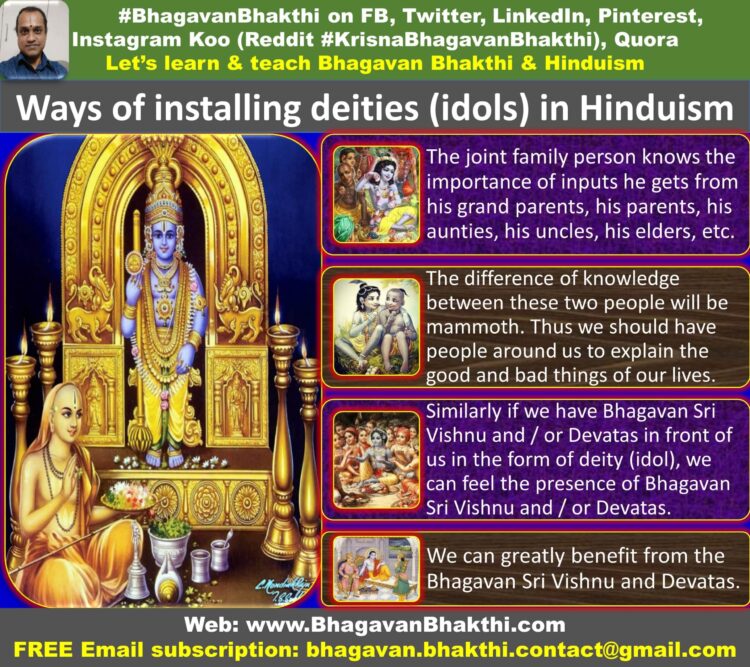
Now let us understand why deity (Idol) worship is one of the best ways of worshipping Lord Sri Vishnu and other Devatas (Demigods).
Let us take an example of how deity (Idol) worshipping is the best way of worshipping by taking joint family as an example.
In a single joint family if a person has his grand parents, parents, uncles and aunties in front of him, then he would know the importance of all of them.
That person knows why joint family is important.
He can see all of them on daily basis. He can learn many things on daily basis.
His maturity would be something different compared to a person who is living alone or living with one or two persons.
The joint family person knows the importance of inputs he gets from his grand parents, his parents, his aunties, his uncles, his elders, etc.
Whereas a person who is living along or living with one or two people, what can be expected?
The difference of knowledge between these two people will be mammoth.
Thus we should have people around us to explain the good and bad things of our lives.
Similarly if we have Bhagavan Sri Vishnu and / or Devatas in front of us in the form of deity (idol), we can feel the presence of Bhagavan Sri Vishnu and / or Devatas.
We can greatly benefit from the Bhagavan Sri Vishnu and Devatas.
Bhagavan Sri Vishnu and Devatas are having form.
Only fools and stupid people tell that Lord Sri Vishnu and Devatas are formless.
Just because we have not seen our grand parents or great grand parents, it doesn’t mean we don’t have our grand and great grand parents.
Because they were there, that’s why we are here. We are their lineage.
Thus we are lineage of svayam Lord Sri Vishnu. He is having the greatest form.
In Sri Vishnu Sahasra nama, it is very clearly mentioned that Sri Vishnu is:
|| “सहस्र पात्, सहस्र अक्ष, सहस्र शिर” | “ಸಹಸ್ರ ಪಾತ್, ಸಹಸ್ರ ಅಕ್ಷ, ಸಹಸ್ರ ಶಿರ” | “sahasra pāt, sahasra akṣa, sahasra śira” ||
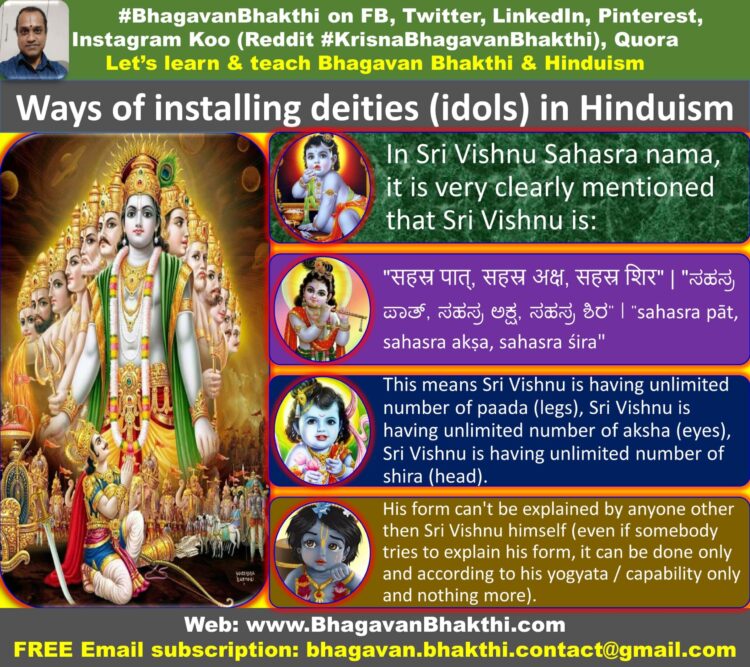
This means Sri Vishnu is having unlimited number of paada (legs), Sri Vishnu is having unlimited number of aksha (eyes), Sri Vishnu is having unlimited number of shira (head).
His form can’t be explained by anyone other then Sri Vishnu himself (even if somebody tries to explain his form, it can be done only and according to his yogyata / capability only and nothing more).
Even Sri Mahalakshmi tells in “amruni sookta”, that she is the having great powers, she is having the powers of creating, looking after and destroying the unlimited universes.
But She can do all these only with the aashirvaada of her husband Sri Vishnu.
Without his help and support she can’t be anything. That’s the greatness of Sri Vishnu.
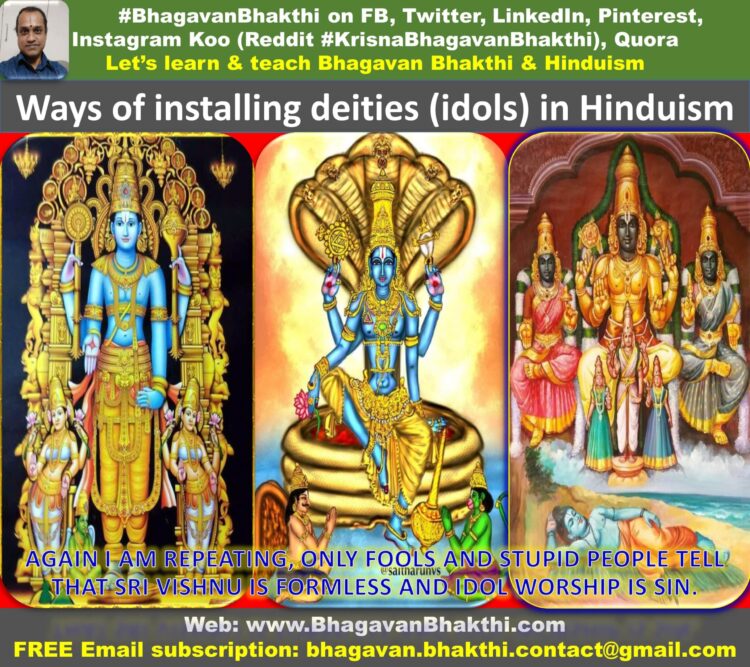
AGAIN I AM REPEATING, ONLY FOOLS AND STUPID PEOPLE TELL THAT SRI VISHNU IS FORMLESS AND IDOL WORSHIP IS SIN.
The following has been taken from Varaha Purana.
Varaha purana has been explained by Swayam Lord Sri Varaha Swamy (one of the avatar of Sri Vishnu) to his beloved wife Prithvi or BhooDevi / Mother earth.
List of ways of installing deities (idols) in Hinduism are as given below:
1. IDOL MADE OF WOOD
2. IDOL MADE OF STONE
3. IDOL MADE OF EARTHEN AND COPPER IDOLS
4. IDOL MADE OF BRONZE5.
5. IDOL MADE OF SILVER AND GOLD
Now, let us know the “List of ways of installing deities (idols) in Hinduism” with explanation:
IDOL MADE OF WOOD
Prithvi requested Lord Varaha to describe the proper methods of installing various types of idols.
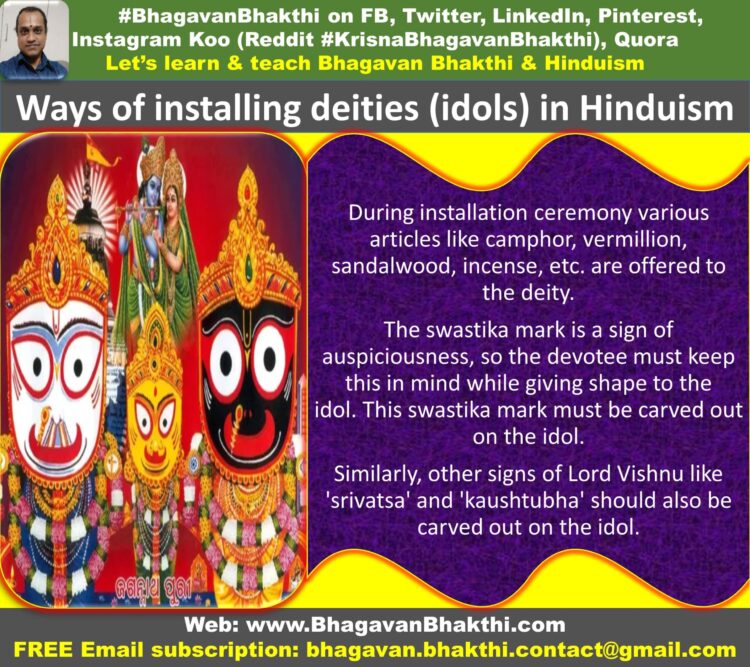
Lord Varaha replied that a devotee desirous of making a wooden idol must select the wood of ‘Bassia latifolia’ for his purpose.
The wood should be purified and then given shape as per the appearance of the deity.
The idol is then installed in a temple amidst the performance of appropriate.
During installation ceremony various articles like camphor, vermillion, sandalwood, incense, etc. are offered to the deity.
The swastika mark is a sign of auspiciousness, so the devotee must keep this in mind while giving shape to the idol.
This swastika mark must be carved out on the idol.
Similarly, other signs of Lord Vishnu like ‘srivatsa’ and ‘kaushtubha’ should also be carved out on the idol.
Lord Vishnu is then invoked and requested to dwell within that idol by chanting mantras.
After the deity has been invoked, the ‘wood’ no longer remains a lifeless structure but it becomes the embodiment of the deity.
The idol is then considered to be fit for worship. While worshipping, a devotee should offer a bhoga of kheer to the deity.
Burning a ghee or sesame-oil lamp in front of the deity is considered good.
The devotee should then circumambulate around the temple premise.
While circumambulating, he should keep on chanting the sacred mantra ‘om namo narayanaya’.
The idol thus installed should be worshipped daily without failure.
IDOL MADE OF STONE
A proficient sculptor should be chosen to carve out the deity’s shape from a pure and spotless stone.
First of all the sculptor should clearly draw the outline of deity’s appearance on the stone with a marker and then carefully carve it out from the stone.
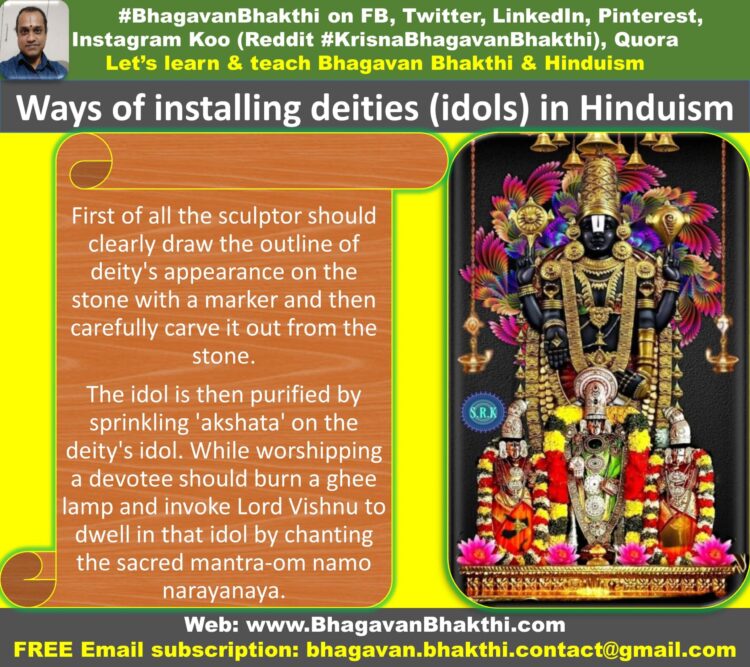
The idol is then purified by sprinkling ‘akshata’ on the deity’s idol.
While worshipping a devotee should burn a ghee lamp and invoke Lord Vishnu to dwell in that idol by chanting the sacred mantra-om namo narayanaya.
The installation of idol being complete, he should observe a fast for the whole night.
Next morning, after finishing his daily chores he should put on white clothes and change his old ‘yagyopavita’ with a new one.
The idol thus made is considered fit to be worshipped.
Purva bhadrapada is considered to be the best time for the installation of a stone-idol.
During the course of installation ceremony, a devotee should live either on milk or cereal like barley.
The rituals of worship consist of numerous activities like lighting four lamps in front of the deity, keeping four small pots each filled up with articles like ‘panchagavya‘, water, sandalwood and milk.
The rituals of worship are considered to be incomplete without the chantings of vedic mantras.
IDOL MADE OF EARTHEN AND COPPER IDOLS
A devotee should carefully make a beautiful earthen idol without any sign of crack.
The most auspicious time for the installation of an earthen idol is said to be during ‘shravana nakshatra’.
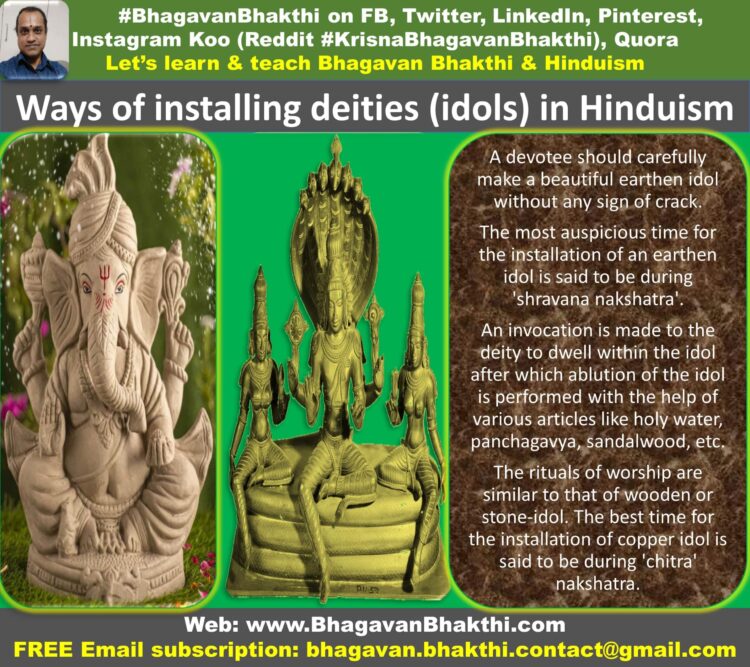
An invocation is made to the deity to dwell within the idol after which ablution of the idol is performed with the help of various articles like holy water, panchagavya, sandalwood, etc.
The rituals of worship are similar to that of wooden or stone-idol.
The best time for the installation of copper idol is said to be during ‘chitra’ nakshatra.
The idol should be installed facing north and should be purified with the help of holy water, panchagavya, etc.
Then the deity is invoked to dwell within the idol. The invocation is made by chanting sacred mantras.
Now, the idol is fit to be worshipped. The rituals are same as mentioned earlier.
IDOL MADE OF BRONZE
The most auspicious time for the installation of bronze-idol is said to be during jyeshtha nakshatra.
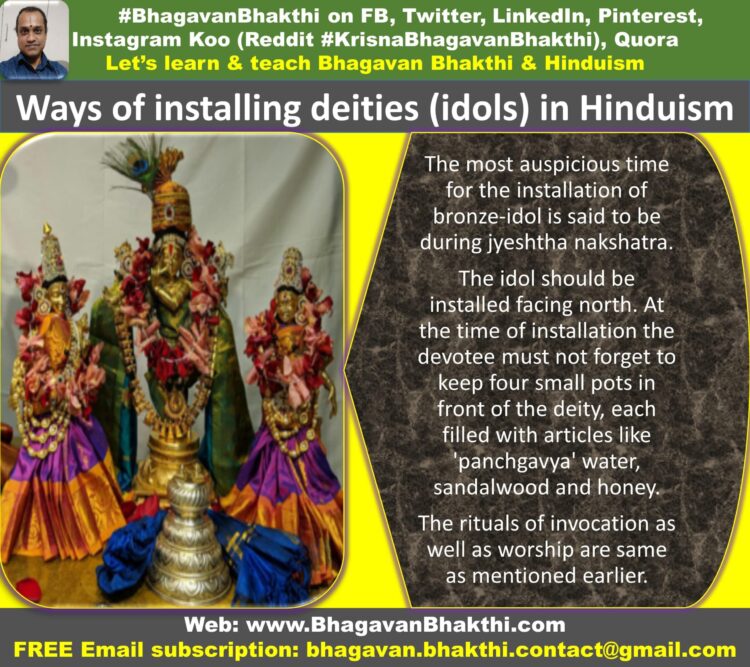
The idol should be installed facing north.
At the time of installation the devotee must not forget to keep four small pots in front of the deity, each filled with articles like ‘panchgavya’ water, sandalwood and honey.
The rituals of invocation as well as worship are same as mentioned earlier.
IDOL MADE OF SILVER AND GOLD
The rituals for the installation of silver or gold idols are similar to that of copper or bronze idol.
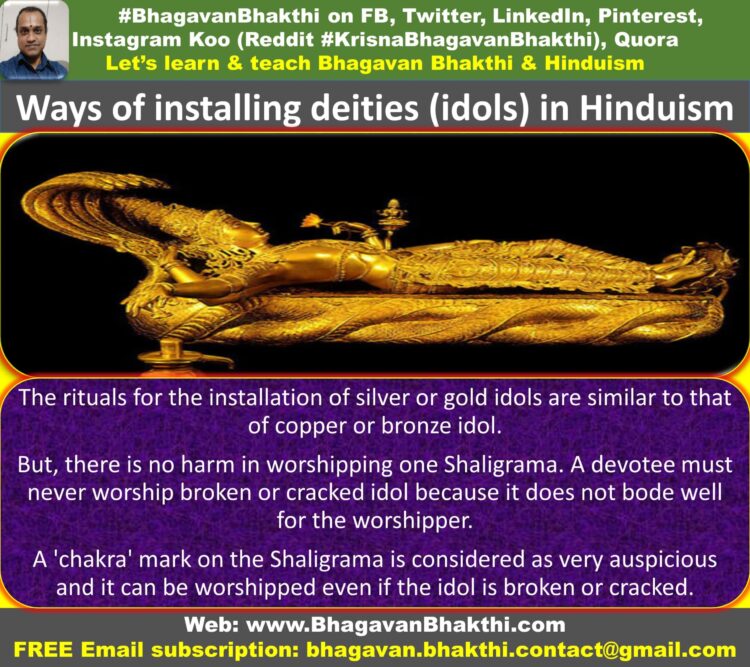
Prithvi requested Lord Varaha to reveal the name of deities whom a devotee can worship at home.
Lord Vishnu replied – A devotee can worship any deity at home but worship of two Shiva Lingas is prohibited.
Similarly, a devotee should never worship three Shaligramas or three Durga idols or two Surya idols.
A devotee should also never worship Shaligramas adding up to odd numbers – 3, 5, 7, etc.
But, there is no harm in worshipping one Shaligrama.
A devotee must never worship broken or cracked idol because it does not bode well for the worshipper.
A ‘chakra’ mark on the Shaligrama is considered as very auspicious and it can be worshipped even if the idol is broken or cracked.
The virtues attained by worshipping twelve Shaligramas are similar to that of worshipping twelve crore Shiva Lingas.
Partaking of ‘charanamrita’ that has been offered to Shaligrama absolves a man from all his sins.
But, a devotee should never partake any ‘prasada’ that has been offered to Shiva Linga.
Anybody who either buys or sells a Shaligram is certain to go to hell.
More information will be added to this on regular, please visit after some time to know more information.
To watch videos on #Hinduism #Sanskrit language, SUBSCRIBE to my YouTube channel from this below link:
#BhagavanBhakthi YouTube channel
To know “why idol worship is done in Hinduism“, you can visit this link to gather more information:
Why Hindus worship Idols, correct meaning
To know more about “Hinduism important information“, please click the below link:
Hinduism important information
To know the significance of the months of Kartika, Margashirsha and Vaishaka, you can click the below link:
Significance of the months of Kartika, Margashirsha and Vaishaka
Dear friends, if you need any clarifications about this post, kindly let me know, I will definitely try to answer all of them.
Also your one LIKE, one COMMENT, One Share, one SUBSCRIPTION is highly important.
This will help to know the quality of this content and also it will be helpful to know if any improvements is required for the content.
If you feel this content is useful to you and has helped you to improve your knowledge, kindly share this with your well-wishers.
Because “SHARING MEANS CARING”.
For receive FREE EMAIL SUBSCRIPTION about #BhagavanBhakthi, you can send an email to bhagavan.bhakthi.contact@gmail.com from your email ID.
NAMASTE!
Sri Gurubhyo Namaha
Sri Krishnaaya Namaha
Sri Krishnaarpanamastu
Subscribe / Follow us Share in Social Media